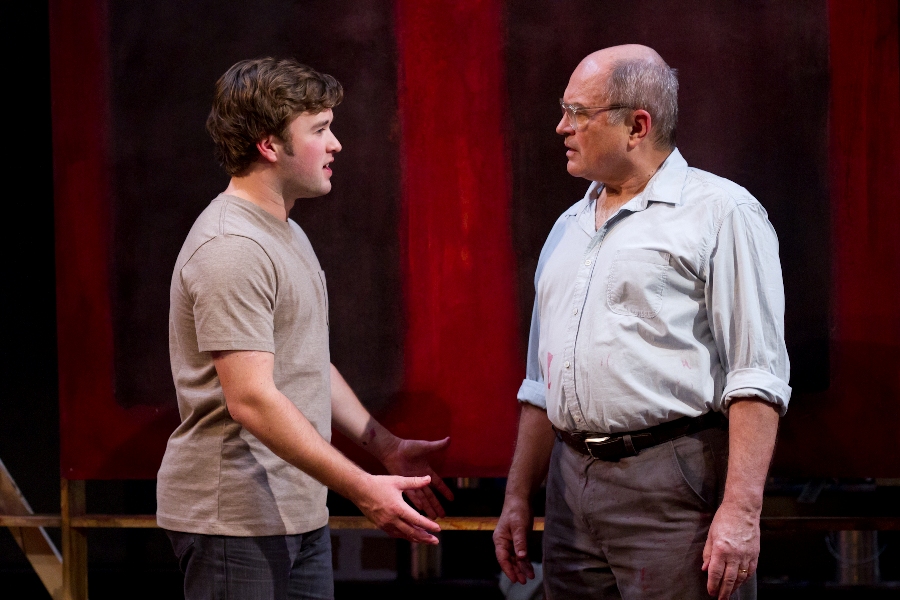
Haley Joel Osment and Stephen Rowe in Philadelphia Theatre Company’s RED; both actors did extensive research on Mark Rothko and his work, including Osment’s trip to the Tate Gallery in London to view the artist’s original paintings. (Photo credit: Mark Garvin)
The myth of the artist–the temperamental iconoclast and social outsider for whom standard rules of behavior do not apply—finds some basis in reality with the Latvian-born American painter Mark Rothko (1903-70). Yet the Abstract Expressionist–who railed against being categorized as such–was much more than a bohemian stereotype; he was, in fact, a tormented soul filled with profound passion, severe depression, and unresolved contradictions. RED is a compelling examination of the complex psychology and emotions of the problematic modern artist, presenting him as both a self-indulgent egomaniac and an inspired genius, equal parts intellectual and misanthrope, who could relate much better to paintings than to people.
John Logan’s fictionalized biographical drama is set in Rothko’s darkened studio on the Bowery in 1958-60, when he was at work on a major, ill-fated commission for Manhattan’s Four Seasons Restaurant, in the newly completed Seagram’s Building (designed by two masters of modern architecture, Mies van der Rohe and Philip Johnson). There the artist and a paid intern engage in provocative, adversarial discussions about the nature, meaning, importance, and seriousness of painting, while preparing the series of canvases.
Fortunately for posterity, Rothko wrote and lectured extensively, and was the subject of revealing interviews, in which he adamantly expressed his views on art. Logan’s 90-minute play relies heavily on these original sources and quotations; it is well researched, intelligently written, and, in the Philadelphia Theatre Company’s current production, sensitively acted and directed.
The two-man cast of Stephen Rowe as Rothko and Haley Joel Osment as the young studio assistant, Ken, bring depth and believability to their characters. Rowe is simultaneously gruff, imperious, and tortured as the unyielding tragic hero, and Osment convincingly portrays the maturation of his protégé from hesitant sycophant, to bullied employee, to self-confident young man who can hold his own against his famous elder.

In a powerful scene that foreshadows the artist’s bloody suicide a decade later, Haley Joel Osment as Ken cleans red paint off the arms of an intoxicated Rothko, played by Stephen Rowe, in Philadelphia Theatre Company’s production of RED. (Photo credit: Mark Garvin)
James Noone’s set design, along with the exacting props (including recreations of Rothko’s paintings), creates an authentic indication of the artist’s studio, his works, and his working method. Effective lighting by Tyler Micoleau and sound by Josh Schmidt further enhance the ambiance of the artist’s self-imposed isolation and intense artistic focus, to the exclusion of the outside world.
In the end, a self-destructive Rothko, who reneged on the Seagram’s contract and returned his patron’s $35,000 advance, is seen wallowing in the loneliness, depression, and self-medication through alcohol and nicotine (and, ultimately, prescription barbiturates), that would result in his suicide by razorblade on February 25, 1970. His refusal to grow with the times, to embrace change, to accept that Abstract Expressionism had long become passé, and to acknowledge that Modern Art had succumbed to the Post-Modernism of Pop, would be his downfall.
An angry man who often saw red, Rothko was also a purist, who understood the infinite gradations, significations, and moods of color that gave meaning and humanity to his non-figural art. As he asserted in 1947, in one of his weekly lectures for the California School of Fine Arts, “The most interesting painting is one that expresses more of what one thinks than of what one sees.” RED is a play that makes the audience think and see, by successfully elucidating the inner spirit of the man and his work.
RED
by John Logan
Directed by Anders Cato
October 14-November 13, 2011
Philadelphia Theatre Company
Suzanne Roberts Theatre
Broad & Lombard Streets
Philadelphia, PA 19146
215.985.0420
www.PhiladelphiaTheatreCompany.org


1 comment
[…] of living the Great Artist myth and of trying to please a bunch of privileged snobs. (Except for this piece, but it still blames Rothko for not “growing with the […]